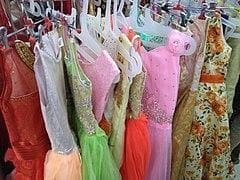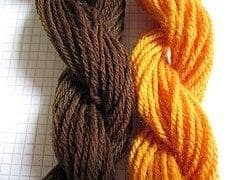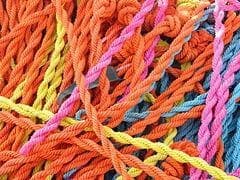Synthetic Fibre - Definition, Examples, Uses, FAQs
What is Synthetic Fibre?
Synthetic fibres are obtained from chemicals or petrochemicals and are made from raw materials such as petroleum. These materials are used to make several sorts of fibres by polymerising them into a long, linear with diverse chemical components. Synthetic fibres are used in nearly every fibre and textile technology aspect, accounting for over half of all fibre utilisation. Many kinds of synthetic polymer fibres have been studied as potentially significant commercial products; three of the most popular are nylon, polyester, and rayon.
The earliest synthetic fibres were created in the nineteenth century. The requirement for stronger fibres that could endure a lot of pressure was one of the key reasons for their development.
NEET 2025: Mock Test Series | Syllabus | High Scoring Topics | PYQs
JEE Main: Study Materials | High Scoring Topics | Preparation Guide
JEE Main: Syllabus | Sample Papers | Mock Tests | PYQs
- What is Synthetic Fibre?
- Examples of synthetic fibre
- Uses of synthetic fibre

Also read -
- NCERT Solutions for Class 11 Chemistry
- NCERT Solutions for Class 12 Chemistry
- NCERT Solutions for All Subjects
Examples of synthetic fibre
The following are some of the most prevalent examples of synthetic fibre or artificial fibres:
Rayon:
Rayon is a semisynthetic material manufactured from a mixture of wood pulp (cellulose), carbon disulphide, and sodium hydroxide. It is used to imitate natural fibres such as cotton and silk. There are also numerous rayon subtypes.
Nylon:
Nylon is a synthetic fibre created solely by chemical processes and is one of the most widely used.
Polyester:
Polyester is a popular man-made fibre or artificial fibre that is produced chemically from plant proteins and is commonly utilised in the production of plastic bottles. The key features are its strong strength and longer shelf life.
Some other examples of artificial fibre.
Dacron, lyocell, modal, PAN, asbestos, spandex, and polyurethane are examples of artificial fibre.
Advantages of synthetic fibre
- Synthetic clothes made from synthetic fibres are extremely long-lasting and doesn't wrinkle readily.
- Synthetic clothes are stretchable and can be stretched out easily.
- Synthetic fibres are sturdy and capable of bearing a heavy load.
- Because they are soft, they are commonly used to make garments from synthetic clothes.
- They are less expensive than natural fibres.
Disadvantages of synthetic fibre
- The majority of synthetic fibres do not absorb water.
- When synthetic fibres are washed in hot water, they might be damaged.
- When compared to natural fibre, they are more prone to catching fire.
Uses of synthetic fibre
For non-textile applications, a variety of synthetic fibres are utilised. Some of these are combined with natural fibres to create sophisticated fabrics that combine the best of both worlds. A stretchable fabric used for shirting and other clothing materials is an example of this method. Synthetic clothes are therefore popular. It not only improves the appearance and feel of the product, but it also improves the quality.
Related Topics Link, |
Following are some uses along with the properties of synthetic fibres.
Uses of synthetic fibre: Rayon
- Rayon is a soft, absorbent, and pleasant material.
- It's simple to dye in a variety of colours.
- Bedsheets are made from a blend of rayon and cotton.
- Carpets are made from a blend of rayon and wool.

Uses of synthetic fibre: Nylon
- Nylon is a glossy, easy-to-clean, and stretchable fabric.
- It's quick to dry and holds its shape.
- Nylon is used in automobile seat belts, sleeping bags, stockings, ropes, and other products.
- Nylon is also utilised in the manufacture of parachutes and fishing nets and ropes for rock climbing.

NCERT Chemistry Notes:
Uses of synthetic fibre: Polyester
- Polyester is made up of esters, which are repeating units of a chemical.
- Polyester is wrinkle-free and easy to launder, making it an excellent choice for dressmaking.
- Polyester maintains its form and crispness.
- Polyester is used in making make ropes, nets, raincoats, and jackets, among other things.

Also check-
Frequently Asked Questions (FAQs)
Synthetic fibres are obtained from chemicals or petrochemicals and are made from raw materials such as petroleum. Chemicals derived from petroleum or petrochemicals are utilised to make such fibres. These materials are polymerised into a molecule that binds two nearby carbon atoms together.
Artificial Fibre
Synthetic fibres are utilised in the production of ropes, fishing nets, and seat belts. Polyester is a wrinkle-free and easy-to-clean fabric manufactured from coal and oil (petrochemicals). Caps, raincoats, and ropes are all made from synthetic fibre.
Natural Fibre
Synthetic fibre are long-lasting, with excellent wear and tear resistance. Synthetic fabric is highly durable as a result of this. These fibres have an excellent lustre and do not yellow with age.
Petroleum
Also Read
21 Jul'22 03:58 PM
11 Jul'22 04:41 PM
07 Jul'22 04:26 PM
